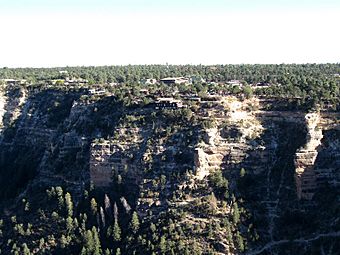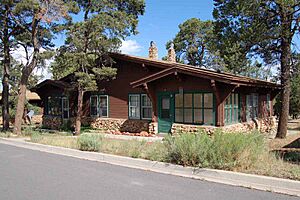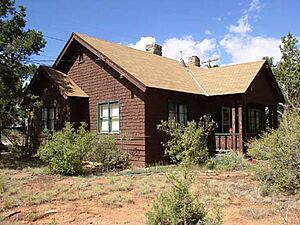Grand Canyon Village Historic District facts for kids
|
Grand Canyon Village Historic District
|
|

Grand Canyon Village
|
|
| Location | Grand Canyon, Arizona |
|---|---|
| Architect | Daniel Ray Hull, Kolb, Ellsworth & Emery; Mary E.J. Colter Charles Whittlesey |
| Architectural style | Park Service Rustic, Pueblo, Bungalow/craftsman |
| NRHP reference No. | 75000343 (original) 95001226 (increase) |
Quick facts for kids Significant dates |
|
| Added to NRHP | November 20, 1975 |
| Boundary increase | October 24, 1995 |
| Designated NHLD | February 18, 1987 |
The Grand Canyon Village Historic District is the old and important center of Grand Canyon Village. It sits on the South Rim of the amazing Grand Canyon in Grand Canyon National Park, Arizona. This area includes many famous buildings and structures. Many of these are even considered National Historic Landmarks or are listed on the National Register of Historic Places.
The way the village was planned is also very special. It was designed to fit in perfectly with the Grand Canyon landscape. It uses a style called National Park Service Rustic design. This style makes buildings look like they are part of nature. You'll also find unique buildings here, like the famous El Tovar Hotel.
Contents
How Grand Canyon Village Was Designed
Grand Canyon Village was carefully planned by the National Park Service. It was meant to be a complete tourist area on the South Rim. It is the biggest example of town planning by the Park Service in all national parks.
The village first grew around the end of the Grand Canyon Railway line. As time went on, both the Park Service and the company that ran the park's services, the Fred Harvey Company, built more things. The first main buildings were the El Tovar Hotel and the Bright Angel Lodge. Both were run by the Fred Harvey Company.
The El Tovar Hotel opened in 1905. It was built by the Atchison, Topeka and Santa Fe Railway right on the canyon rim. A new train station was built next to the hotel in 1909. Most of the early buildings in the village were built by these private companies.
Planning for the Future
In 1910, even before the Grand Canyon became a national park, leaders suggested a plan for future building. Mark Daniels, who managed the parks in 1914, also wanted a full plan. This plan would include water, sewer, power, and phone systems.
In 1924, a master plan was created by Daniel Ray Hull. He was a landscape architect for the National Park Service. His plan set up a "village square" where the railroad met the east road, near the El Tovar. The first park office building was put there.
Hull used the natural shape of the land to guide his plan. He placed homes on two small hills, separated by a stream. This kept the main hotel area near Bright Angel Camp and the El Tovar. Another open area was planned near the new south entrance road. It was meant to have an office, post office, and museum. Over time, this area became a parking lot.
Homes in the Village
The homes in the village were built in different styles, including bungalows. Homes for Park Service employees were special. Cars would park behind the houses, and the front doors faced a shared open space. This was one of the first times this kind of layout was used in a planned community.
Homes for Fred Harvey Company workers were more traditional. They faced the street, with alleys behind them for garages. In the late 1930s, many improvements were made by the Civilian Conservation Corps. This group helped with landscaping, like moving native plants to areas that had been disturbed by building.
Important Buildings and Features
Many parts of Grand Canyon Village are simple landscape features. These include sidewalks, stone walls, and culverts. The stone wall along the canyon rim is a key feature. It was built in stages between 1905 and 1934. About 44 such structures are considered important. Most are made from local Kaibab limestone.
The district has many important buildings. Some are National Historic Landmarks, and others are on the National Register of Historic Places. These buildings can be grouped into two types:
- Fancy buildings built by park companies, many designed by Mary Colter.
- Simpler buildings in the National Park Service Rustic style. These were designed by Hull and Thomas Chalmers Vint for park offices and homes.
Buildings by Park Companies
Here are some of the buildings built by the park companies:
- The El Tovar Hotel (1905) was built by the AT&SF Railway as a fancy hotel. It was designed by architect Charles Frederick Whittlesey and is a National Historic Landmark.
- The Bright Angel Lodge (1935) includes the old Buckey O'Neill Cabin. Architect Mary Colter rebuilt most of this hotel.
- The Buckey O'Neill Cabin (1897) is the oldest building on the South Rim. It is listed on the National Register of Historic Places.
- The Lookout Studio (1914) is west of the Bright Angel Lodge. Designed by Colter, it was made for viewing the canyon. It also has a small gift shop. It is part of the Mary Jane Colter buildings National Historic Landmark.
- Hopi House (1905) was designed by Colter to look like a Hopi village. It is east of the El Tovar. This building was a "living museum" where Hopi artists showed and sold their crafts. It is also part of the Mary Jane Colter National Historic Landmark.
- The El Tovar Stables (1904) were built for horses and mules. These animals were used for transport before cars were common. Today, mules for the Bright Angel Trail still live here. It is listed on the National Register of Historic Places.
- The Kolb Brothers Studio (1904) was started by brothers Ellsworth and Emery Kolb. They showed films and slide shows of the Grand Canyon here. The building hangs over the canyon rim at the start of the Bright Angel Trail. It grew to five stories and has a small theater.
- Verkamp's Curio Store (1906) is now Verkamp's Visitor Center. It is run by the National Park Service. John George Verkamp built it to sell Native American crafts. The two-story building looks like an adobe building. Members of the Verkamp family lived upstairs until 1978. In 2008, the family decided not to continue running the store. The Park Service then made it into a visitor center.
- The Grand Canyon Power House was built by the AT&SF to provide electricity. It is special because it uses rustic design for an industrial building. It is an individually listed National Historic Landmark.
- The Grand Canyon Depot (1910) and Grand Canyon Railway (1905) were built by the AT&SF. The depot, designed by Francis W. Wilson, is a National Historical Landmark. The railway is on the National Register of Historic Places.
- The AT&SF Employee residences were built for company workers. These homes were larger than the Park Service ones. They had garages at the back, accessed by alleys.
Buildings by the Park Service
Here are some of the buildings built by the National Park Service:
- The Grand Canyon National Park Superintendent's Residence (1921) was first the park's main office. It was designed in the National Park Service Rustic style by Hull. In 1931, Vint changed it to be the superintendent's home. It is listed on the National Register of Historic Places.
- The Grand Canyon Park Operations Building (1929) replaced the first headquarters. It is now the park's law enforcement center. It is a National Historic Landmark.
- The Grand Canyon South Rim Ranger's Dormitory (1920) was built for workers. In 1927, it was changed to house park rangers. It is listed on the National Register of Historic Places.
- The Park Service Employee residences (1924–1933) were built under Hull and Vint's direction. They were placed on circular streets, facing a shared walking area. The 16 houses were designed in the NPS Rustic style.
Other important buildings include dorms, shops, a jail, a firehouse, the park hospital, a post office, and two schools. Some newer buildings, like the Thunderbird and Kachina lodges, are not considered historic.
Historic Landmark Status
The Grand Canyon Village was first added to the National Register of Historic Places on November 20, 1975. This included 39 buildings. In 1982, the Bright Angel Lodge and 25 more buildings were added. The area was then named a National Historic Landmark District on February 18, 1987.
On October 24, 1995, the district was made even larger. It now includes the historic center of Grand Canyon Village. Today, the district has 247 buildings, 55 landscape structures, and three sites. The National Register district also includes two cemeteries that are not part of the National Historic Landmark district.





